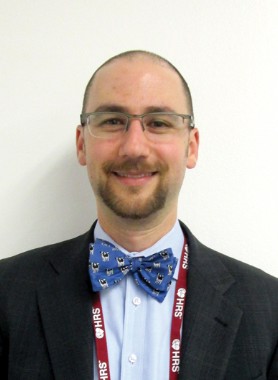User login
SAN FRANCISCO – Adding an electrocardiogram to standard preparticipation screening of high school athletes significantly increased the likelihood of identifying disorders associated with sudden cardiac death, a prospective study of nearly 5,000 athletes showed.
"At this point I’m not advocating that an ECG should definitely be added to the screening, and I’m not advocating that the ECG should replace the history and physical," lead author Dr. Jordan M. Prutkin emphasized in an interview at the annual scientific sessions of the Heart Rhythm Society.
"I think we need to be doing more research to figure out what the correct history questions to be asking are. For instance, I think a family history is one of the most important questions to ask about, as is syncope. We also need to find the best ECG criteria that are going to give you the best sensitivity and specificity in an athletic population."
The American Heart Association currently recommends the use of a history and physical in the preparticipation screening of athletes, but it does not recommend use of an ECG.
No definitive data exist to support using a history and physical only to detect heart abnormalities, noted Dr. Prutkin, an electrophysiologist at the University of Washington’s Center for Sports Cardiology, Seattle. "We also don’t have a lot of data that compares the history and physical to an ECG," he said. "The idea of using ECG for screening is a debated topic. In this study we tried to compare the ECG to a history and physical in terms of picking up those things that portend a risk of sudden cardiac arrest on the playing field or in life."
Between October 2010 and June 2013 the researchers conducted preparticipation screening of 4,812 athletes aged 13-19 at 23 high schools in the Seattle area. The protocol included a heart health questionnaire, physical exam recommendations based on AHA guidelines, and a resting 12-lead ECG that was interpreted according to athlete-specific criteria and limited echocardiography.
Slightly more than half of the athletes (54%) were male and 65% were white. In all, 23 athletes (.5%) were found to have a significant cardiac abnormality that required further evaluation. Abnormal history or physical exam led to a diagnosis in 61% of the disorders, while an abnormal ECG led to a diagnosis in 70% of the disorders. In addition, history, physical examination, and ECG had false-positive rates of 22.3%, 14.9%, and 3.6%, respectively, and positive predictive values of 1.0%, 1.0%, and 8.6%.
"Our results matched what we had been seeing [in practice], which is that trying to do a good history in a high school student is very difficult, because a lot of them will complain of chest pain or palpitations," Dr. Prutkin said. "Some of the problems with the history and physical [center around] what are the more directed questions to ask? Do we need to revise the preparticipation examination to get better questions? Also, when interpreting the ECGs, you need to use athlete-specific criteria. By doing that, you can significantly decrease your false-positive rate. You can’t just interpret an ECG the way that you would normally interpret an ECG in a 50-year-old."
He acknowledged certain limitations of the study, including the fact that a screening echocardiogram was used instead of a full echocardiogram. "We looked for coronary artery anomalies, but that’s not always possible to see on a screening echocardiogram, so we may have missed some of those," he said. "We also may have missed some cases of long QT syndrome or hypertropic cardiomyopathy. This is screening; even with the ECG it’s not going to be perfect, but hopefully we are finding those who are at highest risk."
The Nick of Time Foundation helped to arrange the screenings. Dr. Prutkin said that he had no conflicts of interest to disclose.
SAN FRANCISCO – Adding an electrocardiogram to standard preparticipation screening of high school athletes significantly increased the likelihood of identifying disorders associated with sudden cardiac death, a prospective study of nearly 5,000 athletes showed.
"At this point I’m not advocating that an ECG should definitely be added to the screening, and I’m not advocating that the ECG should replace the history and physical," lead author Dr. Jordan M. Prutkin emphasized in an interview at the annual scientific sessions of the Heart Rhythm Society.
"I think we need to be doing more research to figure out what the correct history questions to be asking are. For instance, I think a family history is one of the most important questions to ask about, as is syncope. We also need to find the best ECG criteria that are going to give you the best sensitivity and specificity in an athletic population."
The American Heart Association currently recommends the use of a history and physical in the preparticipation screening of athletes, but it does not recommend use of an ECG.
No definitive data exist to support using a history and physical only to detect heart abnormalities, noted Dr. Prutkin, an electrophysiologist at the University of Washington’s Center for Sports Cardiology, Seattle. "We also don’t have a lot of data that compares the history and physical to an ECG," he said. "The idea of using ECG for screening is a debated topic. In this study we tried to compare the ECG to a history and physical in terms of picking up those things that portend a risk of sudden cardiac arrest on the playing field or in life."
Between October 2010 and June 2013 the researchers conducted preparticipation screening of 4,812 athletes aged 13-19 at 23 high schools in the Seattle area. The protocol included a heart health questionnaire, physical exam recommendations based on AHA guidelines, and a resting 12-lead ECG that was interpreted according to athlete-specific criteria and limited echocardiography.
Slightly more than half of the athletes (54%) were male and 65% were white. In all, 23 athletes (.5%) were found to have a significant cardiac abnormality that required further evaluation. Abnormal history or physical exam led to a diagnosis in 61% of the disorders, while an abnormal ECG led to a diagnosis in 70% of the disorders. In addition, history, physical examination, and ECG had false-positive rates of 22.3%, 14.9%, and 3.6%, respectively, and positive predictive values of 1.0%, 1.0%, and 8.6%.
"Our results matched what we had been seeing [in practice], which is that trying to do a good history in a high school student is very difficult, because a lot of them will complain of chest pain or palpitations," Dr. Prutkin said. "Some of the problems with the history and physical [center around] what are the more directed questions to ask? Do we need to revise the preparticipation examination to get better questions? Also, when interpreting the ECGs, you need to use athlete-specific criteria. By doing that, you can significantly decrease your false-positive rate. You can’t just interpret an ECG the way that you would normally interpret an ECG in a 50-year-old."
He acknowledged certain limitations of the study, including the fact that a screening echocardiogram was used instead of a full echocardiogram. "We looked for coronary artery anomalies, but that’s not always possible to see on a screening echocardiogram, so we may have missed some of those," he said. "We also may have missed some cases of long QT syndrome or hypertropic cardiomyopathy. This is screening; even with the ECG it’s not going to be perfect, but hopefully we are finding those who are at highest risk."
The Nick of Time Foundation helped to arrange the screenings. Dr. Prutkin said that he had no conflicts of interest to disclose.
SAN FRANCISCO – Adding an electrocardiogram to standard preparticipation screening of high school athletes significantly increased the likelihood of identifying disorders associated with sudden cardiac death, a prospective study of nearly 5,000 athletes showed.
"At this point I’m not advocating that an ECG should definitely be added to the screening, and I’m not advocating that the ECG should replace the history and physical," lead author Dr. Jordan M. Prutkin emphasized in an interview at the annual scientific sessions of the Heart Rhythm Society.
"I think we need to be doing more research to figure out what the correct history questions to be asking are. For instance, I think a family history is one of the most important questions to ask about, as is syncope. We also need to find the best ECG criteria that are going to give you the best sensitivity and specificity in an athletic population."
The American Heart Association currently recommends the use of a history and physical in the preparticipation screening of athletes, but it does not recommend use of an ECG.
No definitive data exist to support using a history and physical only to detect heart abnormalities, noted Dr. Prutkin, an electrophysiologist at the University of Washington’s Center for Sports Cardiology, Seattle. "We also don’t have a lot of data that compares the history and physical to an ECG," he said. "The idea of using ECG for screening is a debated topic. In this study we tried to compare the ECG to a history and physical in terms of picking up those things that portend a risk of sudden cardiac arrest on the playing field or in life."
Between October 2010 and June 2013 the researchers conducted preparticipation screening of 4,812 athletes aged 13-19 at 23 high schools in the Seattle area. The protocol included a heart health questionnaire, physical exam recommendations based on AHA guidelines, and a resting 12-lead ECG that was interpreted according to athlete-specific criteria and limited echocardiography.
Slightly more than half of the athletes (54%) were male and 65% were white. In all, 23 athletes (.5%) were found to have a significant cardiac abnormality that required further evaluation. Abnormal history or physical exam led to a diagnosis in 61% of the disorders, while an abnormal ECG led to a diagnosis in 70% of the disorders. In addition, history, physical examination, and ECG had false-positive rates of 22.3%, 14.9%, and 3.6%, respectively, and positive predictive values of 1.0%, 1.0%, and 8.6%.
"Our results matched what we had been seeing [in practice], which is that trying to do a good history in a high school student is very difficult, because a lot of them will complain of chest pain or palpitations," Dr. Prutkin said. "Some of the problems with the history and physical [center around] what are the more directed questions to ask? Do we need to revise the preparticipation examination to get better questions? Also, when interpreting the ECGs, you need to use athlete-specific criteria. By doing that, you can significantly decrease your false-positive rate. You can’t just interpret an ECG the way that you would normally interpret an ECG in a 50-year-old."
He acknowledged certain limitations of the study, including the fact that a screening echocardiogram was used instead of a full echocardiogram. "We looked for coronary artery anomalies, but that’s not always possible to see on a screening echocardiogram, so we may have missed some of those," he said. "We also may have missed some cases of long QT syndrome or hypertropic cardiomyopathy. This is screening; even with the ECG it’s not going to be perfect, but hopefully we are finding those who are at highest risk."
The Nick of Time Foundation helped to arrange the screenings. Dr. Prutkin said that he had no conflicts of interest to disclose.
AT HEART RHYTHM 2014
Key clinical point: The addition of an ECG in screening of young athletes significantly increased the odds of identifying cardiac problems.
Major Finding: History, physical examination, and ECG used to identify disorders associated with sudden cardiac death had false-positive rates of 22.3%, 14.9%, and 3.6%, respectively, and positive predictive values of 1.0%, 1.0%, and 8.6%.
Data Source: Results from preparticipation screening of 4,812 athletes aged 13-19 at 23 high schools.
Disclosures: The Nick of Time Foundation helped to arrange the screenings. Dr. Prutkin had no conflicts of interest.

